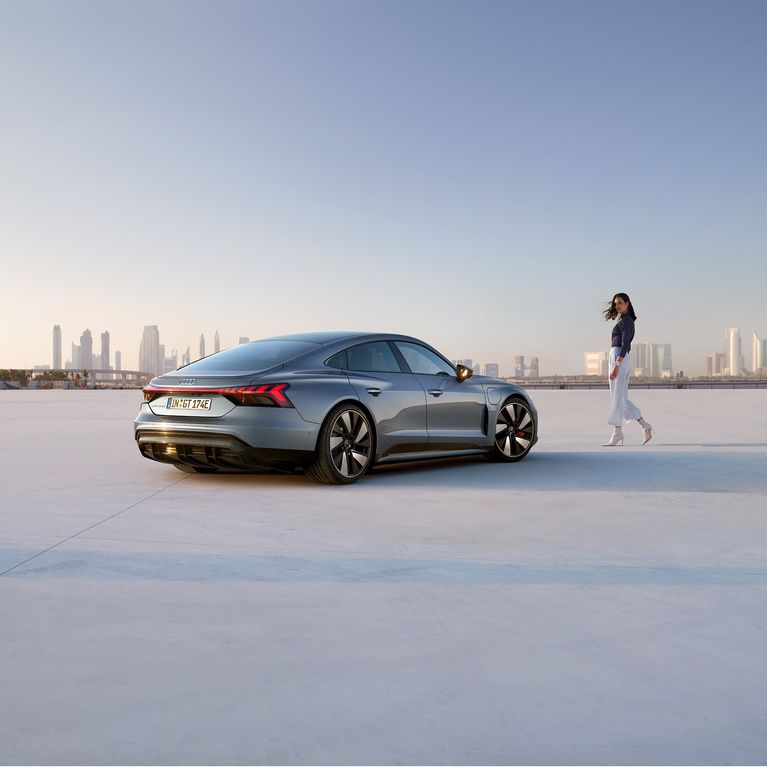
e-tron GT quattro
Pure sportiness and progressive luxury

Pioneering design icon
The design of the Audi e-tron GT quattro² is a rigorous embodiment of electric mobility and unmistakeable Audi DNA.
Electrical consumption combined in kWh/100 km¹: 19.6–18.8 (NEDC); 21.6–19.9 (WLTP); CO₂ emissions combined in g/km¹: 0. Electrical consumption and CO₂ emission figures given in ranges depend on the equipment selected for the vehicle.

Focused on the aesthetics of dynamic handling
In the interior, the Audi e-tron GT quattro² offers plenty of everyday usability paired with the highest quality.
Electrical consumption combined in kWh/100 km¹: 19.6–18.8 (NEDC); 21.6–19.9 (WLTP); CO₂ emissions combined in g/km¹: 0. Electrical consumption and CO₂ emission figures given in ranges depend on the equipment selected for the vehicle.

For an expanded sense of space
The panoramic glass sunroof with its continuous gloss black conveys a generous sense of space in the interior.
Electrical consumption combined in kWh/100 km¹: 19.6–18.8 (NEDC); 21.6–19.9 (WLTP); CO₂ emissions combined in g/km¹: 0. Electrical consumption and CO₂ emission figures given in ranges depend on the equipment selected for the vehicle.

Passion creates progress
Manufacturing the electrically powered gran turismo in the Böllinger Höfe, close to Neckarsulm, is where attention to detail meets precision and quality.
Electrical consumption combined in kWh/100 km¹: 19.6–18.8 (NEDC); 21.6–19.9 (WLTP); CO₂ emissions combined in g/km¹: 0. Electrical consumption and CO₂ emission figures given in ranges depend on the equipment selected for the vehicle.
Output
kW
Acceleration (0–100 km/h)
s
Charging system
volt
Electrical consumption combined in kWh/100 km¹: 19.6–18.8 (NEDC); 21.6–19.9 (WLTP); CO₂ emissions combined in g/km¹: 0. Electrical consumption and CO₂ emission figures given in ranges depend on the equipment selected for the vehicle.
Ideas start the future
The proportions of a gran turismo – flat and wide with a long wheelbase – make it clear that this is where sportiness meets everyday usability. The sculptural design of the body epitomises power and performance

Expressive accents
Aerodynamically optimised shapes become functional details. From the intelligent air inlets at the front to the vented wheel arches and the striking rear diffuser.
Electrical consumption combined in kWh/100 km¹: 19.6–18.8 (NEDC); 21.6–19.9 (WLTP); CO₂ emissions combined in g/km¹: 0. Electrical consumption and CO₂ emission figures given in ranges depend on the equipment selected for the vehicle.
In a nutshell: four doors, five seats
The Audi e-tron GT quattro² is a modern-day demonstration of progress. It radiates sportiness, exclusivity and comfort. The sport seats plus, front with integrated head restraints also feature shaped seat side bolsters to provide good lateral support for cornering and sporty driving.

Tailored digitalisation
Navigate, communicate, obtain information or enjoy the wide range of infotainment options. Using a thrilling operating concept.
Electrical consumption combined in kWh/100 km¹: 19.6–18.8 (NEDC); 21.6–19.9 (WLTP); CO₂ emissions combined in g/km¹: 0. Electrical consumption and CO₂ emission figures given in ranges depend on the equipment selected for the vehicle.

The automotive modernity
The designers opted to use resource-efficient materials. For example, the completely leather-free interior.
Electrical consumption combined in kWh/100 km¹: 19.6–18.8 (NEDC); 21.6–19.9 (WLTP); CO₂ emissions combined in g/km¹: 0. Electrical consumption and CO₂ emission figures given in ranges depend on the equipment selected for the vehicle.
Charging in a new dimension
The 800-volt lithium-ion battery integrated into the flat underbody, offers extremely high performance – both when charging and when driving. In combination with the recuperation system, it provides a range of up to 487 km according to the WLTP measurement procedure.
Energy for 100 km charged in
min
Battery from 5 % to 80% charged in
min
Range (WLTP)
km
Electrical consumption combined in kWh/100 km¹: 19.6–18.8 (NEDC); 21.6–19.9 (WLTP); CO₂ emissions combined in g/km¹: 0. Electrical consumption and CO₂ emission figures given in ranges depend on the equipment selected for the vehicle.

Charging at home⁴
The Audi e-tron GT quattro² can be charged at a maximum alternating current (AC) charging capacity of 11 kW as standard. Faster charging at 22 kW at home requires the optional e-tron charging system connect in combination with the optional on-board charger up to 22 kW (AC).
Electrical consumption combined in kWh/100 km¹: 19.6–18.8 (NEDC); 21.6–19.9 (WLTP); CO₂ emissions combined in g/km¹: 0. Electrical consumption and CO₂ emission figures given in ranges depend on the equipment selected for the vehicle.
A systematic reinterpretation of quattro
In combination with the electric drive system, the fully variable quattro drive ensures power is distributed intelligently to the individual wheels. When sufficient traction is available, it sends power primarily to the front axle.


The sound of the e-tron GT quattro²
#FutureIsAnAttitude News
The next major milestone on the road to the mobility of the future has been unveiled. Get exclusive information about Audi e-tron GT quattro² with #FutureIsAnAttitude News.















